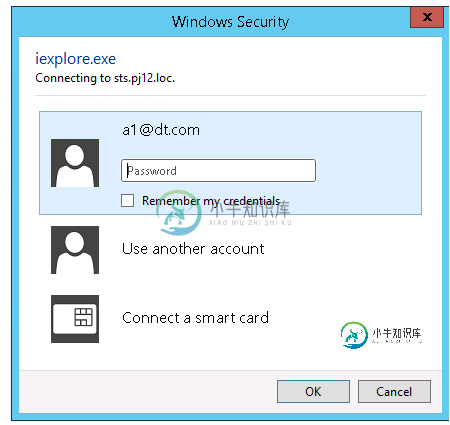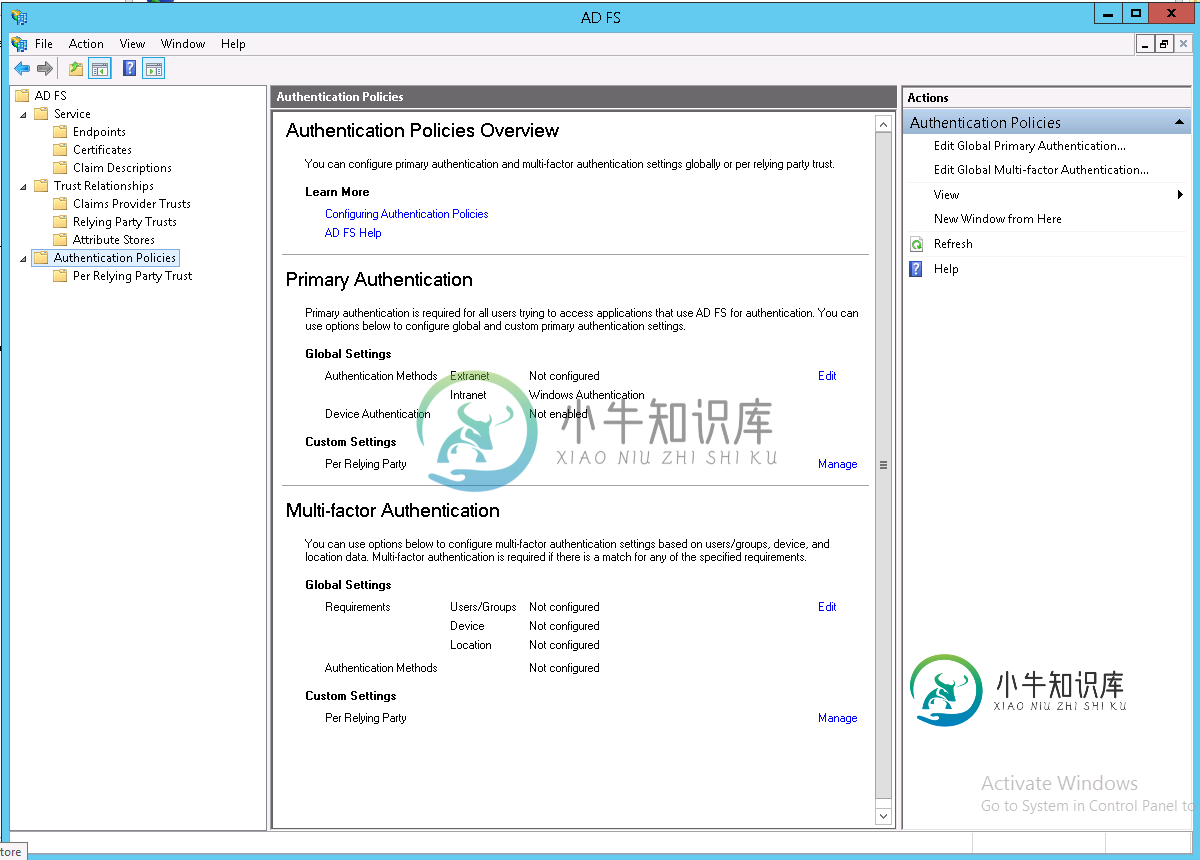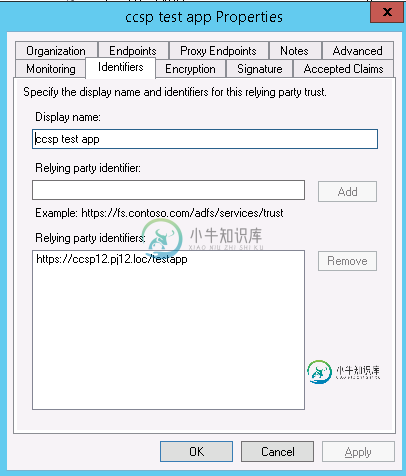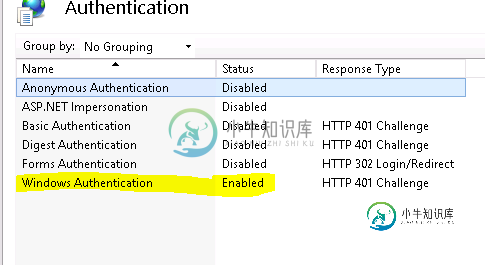ADFS SSO SAML Windows集成身份验证不起作用
我们现在正在进行的项目是使用SAML令牌通过ADFS进行单点登录<此项目应遵循以下基本规则:
1。代理使用其凭据登录到windows
2。代理登录到web应用程序(依赖方)
3。web应用程序应重定向到ADFS中的STS(Active Directory是身份提供程序),并使用代理在其windows身份验证(无缝身份验证)中使用的凭据登录
4。因此,不应显示STS登录页面,并且应验证用户身份。之后,应收到索赔和安全令牌,以便我们授权代理人

配置环境:
1。同一台机器上的域控制器ADFS服务器3.0(Win2k12R2)
2。Web应用程序机器(Win2k12 IIS8.5)
3。机器在同一个域上
ADFS配置:

依赖方配置:


Web应用配置:
身份验证:

<?xml version="1.0" encoding="utf-8"?>
<!--
For more information on how to configure your ASP.NET application, please visit
http://go.microsoft.com/fwlink/?LinkId=169433
-->
<configuration>
<configSections>
<!-- For more information on Entity Framework configuration, visit http://go.microsoft.com/fwlink/?LinkID=237468 -->
<section name="entityFramework" type="System.Data.Entity.Internal.ConfigFile.EntityFrameworkSection, EntityFramework, Version=5.0.0.0, Culture=neutral, PublicKeyToken=b77a5c561934e089" requirePermission="false" />
<section name="system.identityModel" type="System.IdentityModel.Configuration.SystemIdentityModelSection, System.IdentityModel, Version=4.0.0.0, Culture=neutral, PublicKeyToken=B77A5C561934E089" />
<section name="system.identityModel.services" type="System.IdentityModel.Services.Configuration.SystemIdentityModelServicesSection, System.IdentityModel.Services, Version=4.0.0.0, Culture=neutral, PublicKeyToken=B77A5C561934E089" />
</configSections>
<connectionStrings>
<add name="DefaultConnection" providerName="System.Data.SqlClient" connectionString="Data Source=(LocalDb)\v11.0;Initial Catalog=aspnet-TestApp-20150730141753;Integrated Security=SSPI;AttachDBFilename=|DataDirectory|\aspnet-TestApp-20150730141753.mdf" />
</connectionStrings>
<location path="FederationMetadata">
<system.web>
<authorization>
<allow users="*" />
</authorization>
</system.web>
</location>
<system.web>
<authorization>
<deny users="?" />
</authorization>
<authentication mode="None" />
<compilation debug="true" targetFramework="4.5" />
<httpRuntime targetFramework="4.5" />
<pages>
<namespaces>
<add namespace="System.Web.Optimization" />
</namespaces>
<controls><add assembly="Microsoft.AspNet.Web.Optimization.WebForms" namespace="Microsoft.AspNet.Web.Optimization.WebForms" tagPrefix="webopt" /></controls></pages>
<!--<authentication mode="Forms">
<forms loginUrl="~/Account/Login" timeout="2880" defaultUrl="~/" />
</authentication>-->
<profile defaultProvider="DefaultProfileProvider">
<providers>
<add name="DefaultProfileProvider" type="System.Web.Providers.DefaultProfileProvider, System.Web.Providers, Version=1.0.0.0, Culture=neutral, PublicKeyToken=31bf3856ad364e35" connectionStringName="DefaultConnection" applicationName="/" />
</providers>
</profile>
<membership defaultProvider="DefaultMembershipProvider">
<providers>
<add name="DefaultMembershipProvider" type="System.Web.Providers.DefaultMembershipProvider, System.Web.Providers, Version=1.0.0.0, Culture=neutral, PublicKeyToken=31bf3856ad364e35" connectionStringName="DefaultConnection" enablePasswordRetrieval="false" enablePasswordReset="true" requiresQuestionAndAnswer="false" requiresUniqueEmail="false" maxInvalidPasswordAttempts="5" minRequiredPasswordLength="6" minRequiredNonalphanumericCharacters="0" passwordAttemptWindow="10" applicationName="/" />
</providers>
</membership>
<roleManager defaultProvider="DefaultRoleProvider">
<providers>
<add name="DefaultRoleProvider" type="System.Web.Providers.DefaultRoleProvider, System.Web.Providers, Version=1.0.0.0, Culture=neutral, PublicKeyToken=31bf3856ad364e35" connectionStringName="DefaultConnection" applicationName="/" />
</providers>
</roleManager>
<!--
If you are deploying to a cloud environment that has multiple web server instances,
you should change session state mode from "InProc" to "Custom". In addition,
change the connection string named "DefaultConnection" to connect to an instance
of SQL Server (including SQL Azure and SQL Compact) instead of to SQL Server Express.
-->
<sessionState mode="InProc" customProvider="DefaultSessionProvider">
<providers>
<add name="DefaultSessionProvider" type="System.Web.Providers.DefaultSessionStateProvider, System.Web.Providers, Version=1.0.0.0, Culture=neutral, PublicKeyToken=31bf3856ad364e35" connectionStringName="DefaultConnection" />
</providers>
</sessionState>
</system.web>
<system.webServer>
<modules>
<!--<add name="WSFederationAuthenticationModule" type="System.IdentityModel.Services.WSFederationAuthenticationModule, System.IdentityModel.Services, Version=4.0.0.0, Culture=neutral, PublicKeyToken=b77a5c561934e089" preCondition="managedHandler" />-->
<add name="FixedWSFederationAuthenticationModule" type="TestApp.FixedWSFederationAuthenticationModule, TestApp" preCondition="managedHandler" />
<add name="SessionAuthenticationModule" type="System.IdentityModel.Services.SessionAuthenticationModule, System.IdentityModel.Services, Version=4.0.0.0, Culture=neutral, PublicKeyToken=b77a5c561934e089" preCondition="managedHandler" />
</modules>
</system.webServer>
<system.identityModel>
<identityConfiguration saveBootstrapContext="true">
<!-- The identity configuration. No name means default configuration which is always used for passive federation scenarios. see federationConfiguration element -->
<audienceUris>
<add value="https://ccsp12.pj12.loc/testapp" />
</audienceUris>
<issuerNameRegistry type="System.IdentityModel.Tokens.ConfigurationBasedIssuerNameRegistry, System.IdentityModel, Version=4.0.0.0, Culture=neutral, PublicKeyToken=b77a5c561934e089">
<trustedIssuers>
<add thumbprint="91992FCF8B03FF9BD98A259FE93B92620E9DD89A" name="http://sts.pj12.loc/adfs/services/trust" />
</trustedIssuers>
</issuerNameRegistry>
<certificateValidation certificateValidationMode="None" />
</identityConfiguration>
</system.identityModel>
<system.identityModel.services>
<federationConfiguration> <!-- Configures the WSFederationAuthenticationModule (WSFAM) and the SessionAuthenticationModule (SAM) when using federated authentication through the WS-Federation protocol -->
<cookieHandler requireSsl="false" />
<!-- passiveRedirectEnabled true means that a relaying party (test app) instead of having its own login page, it will redirect to the sts issuer for authentication and the sts will reply to the relaying party -->
<!-- Due to WSFederationAuthenticationModule bug, the relaying party address must be with '/' at the end -->
<wsFederation passiveRedirectEnabled="true" issuer="https://sts.pj12.loc/adfs/ls/" realm="https://ccsp12.pj12.loc/testapp/" reply="https://ccsp12.pj12.loc/testapp/" requireHttps="true" />
</federationConfiguration>
</system.identityModel.services>
<!--<runtime>
<assemblyBinding xmlns="urn:schemas-microsoft-com:asm.v1">
<dependentAssembly>
<assemblyIdentity name="DotNetOpenAuth.Core" publicKeyToken="2780ccd10d57b246" />
<bindingRedirect oldVersion="1.0.0.0-4.0.0.0" newVersion="4.1.0.0" />
</dependentAssembly>
<dependentAssembly>
<assemblyIdentity name="DotNetOpenAuth.AspNet" publicKeyToken="2780ccd10d57b246" />
<bindingRedirect oldVersion="1.0.0.0-4.0.0.0" newVersion="4.1.0.0" />
</dependentAssembly>
</assemblyBinding>
</runtime>-->
<entityFramework>
<defaultConnectionFactory type="System.Data.Entity.Infrastructure.SqlConnectionFactory, EntityFramework" />
</entityFramework>
</configuration>
C#代码:
namespace TestApp
{
public partial class _Default : Page
{
protected void Page_Load(object sender, EventArgs e)
{
// local variables
string claimsTypes = string.Empty;
string claimsValues = string.Empty;
string claimsValueTypes = string.Empty;
string claimsSubjectNames = string.Empty;
string claimsIssuers = string.Empty;
// initialize claims and identity
ClaimsPrincipal claimsPrincipal = Thread.CurrentPrincipal as ClaimsPrincipal;
ClaimsIdentity claimsIdentity = Thread.CurrentPrincipal.Identity as ClaimsIdentity;
BootstrapContext bootstrapContext =
ClaimsPrincipal.Current.Identities.First().BootstrapContext
as BootstrapContext;
if (claimsPrincipal != null)
{
signedIn.Text = "You are signed in.";
foreach (Claim claim in claimsPrincipal.Claims)
{
claimsTypes = string.Concat(claimsTypes, "; ", claim.Type);
claimsValues = string.Concat(claimsValues, "; ", claim.Value);
claimsValueTypes = string.Concat(claimsValueTypes, "; ", claim.ValueType);
claimsSubjectNames = string.Concat(claimsSubjectNames, "; ", claim.Subject.Name);
claimsIssuers = string.Concat(claimsIssuers, "; ", claim.Issuer);
}
//claims principals
claimType.Text = claimsTypes;
claimValue.Text = claimsValues;
claimValueType.Text = claimsValueTypes;
claimSubjectName.Text = claimsSubjectNames;
claimIssuer.Text = claimsIssuers;
// ClaimsIdentity
isUserAuthenticated.Text = claimsIdentity.IsAuthenticated.ToString();
authenticationType.Text = claimsIdentity.AuthenticationType;
claimName.Text = claimsIdentity.Name;
// Token
// known bug : http://stackoverflow.com/questions/13514553/wif-4-5-bootstrapcontext-security-token-null
SecurityToken token = null;
if (bootstrapContext.SecurityToken != null)
{
token = bootstrapContext.SecurityToken;
}
else if (!bootstrapContext.Token.Equals(string.Empty))
{
var handlers = FederatedAuthentication.FederationConfiguration.IdentityConfiguration.SecurityTokenHandlers;
token = handlers.ReadToken(new XmlTextReader(new StringReader(bootstrapContext.Token)));
}
SamlSecurityToken sst = token as SamlSecurityToken;
tokenId.Text = sst.Id;
tokenAssertionId.Text = sst.Assertion.AssertionId;
tokenIssuer.Text = sst.Assertion.Issuer;
}
else
{
signedIn.Text = "You are not signed in.";
}
}
}
共有1个答案
最后我能够实现无缝窗口集成SSO!
我发现了一些名为“WIASupportedUserAgents”的ADFS属性。这意味着:支持WIA(Windows集成身份验证)的浏览器
在PowerShell中运行以下操作:
Set-ADFSProperties -WIASupportedUserAgents @("MSIE 6.0", "MSIE 7.0", "MSIE 8.0", "MSIE 9.0", "MSIE 10.0", "MSIE 11.0", "Trident/7.0", "MSIPC", "Windows Rights Management Client", "Mozilla/5.0")
然后重新启动ADFS服务。
为所有浏览器支持设置此属性后,无缝窗口身份验证SSO开始工作!
我现在没有获取凭据窗口,经过身份验证的窗口用户会自动通过ADFS进行身份验证。
很有魅力。
感谢所有人,尤其是Wiktor Zychla,感谢他非常愿意提供帮助!
-
我试图在Symfony中基于这个文档构建一个json身份验证机制:https://symfony.com/doc/current/security/json_login_setup.html 这是我的保安,亚姆 这是我在安全控制器中的方法登录 这是我的登录表 下面您可以看到我发送给控制器的AJAX请求 我收到200状态从服务器,但什么也没发生。安全认证机制完全没有反应。而ajax中的成功方法是不调
-
我已经在我的xamarin Android应用程序中实现了脸书认证,一切都很好。我从facebook获得令牌,并使用firebase rest Api的sigin方法,我能够sigin到firebase,并从firebase Api收到一个访问令牌,作为JWT。但是,当我想在我的Web Api核心上使用这个访问令牌时,它总是返回not authenticated。我的Web Api核心使用下面基于
-
我遵循了这个问题答案的教程:Kafka SASL动物园管理员身份验证 并且我设置了zookeeper.set。acl在服务器中为true。属性,但我仍然可以访问2181端口上的动物园管理员,任何人都可以通过:
-
我的jwt身份验证有问题。 我试图从rest api获取模板列表,但是当我试图访问标题'Authorization'时,值为NULL。下面是我的代码: 前缀和令牌都设置好了,当我将它们记录在控制台中时,我可以看到它们。
-
成员身份验证 PDF版下载 OAuth2简介 如流平台提供了OAuth的授权登录方式,可以使如流客户端(移动端或者桌面端内嵌打开)打开的网页获取成员的身份信息,从而免去登录环节。 企业应用中的URL链接(包括自定义菜单或者消息中的链接),均可通过OAuth2.0验证接口来获取成员的身份信息(UserId)。 第一步:构造网页授权链接 获取用户在如流客户端打开应用(或者链接)时的用户身份,如流提供两
-
我的问题是,我们有一组运行SiteMinder但非常糟糕的遗留代码。它允许IIS匿名并避免使用Active Directory。 我们正在重建此应用程序,并希望将SiteMinder与IIS和集成。净额4.0。我知道我可以构建自己的安全框架,无需用户名和密码即可完成所有工作(因为我们不希望SiteMinder提供),但我想知道是否有办法使用内置的Windows身份验证(窗体或Windows)与Si

